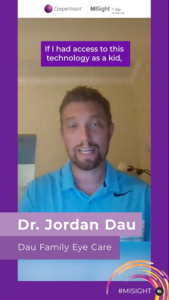sponsored content
June 1, 2023
The introduction of the Topcon MYAH for biometry has given Dr. Dau a better protocol and management process for all his myopia patients.
 When Jordan Dau, OD, first opened his private practice cold five years ago in St. Johns, Florida, he relied on the knowledge he’d gained from working in roughly 25 optometric settings to help him differentiate his practice. His unique experiences ranged from his first job in private practice, to commercial optometry, to one-day fill-in weekend and evening shifts at various optometric settings throughout the greater Jacksonville area. In these different roles, Dr. Dau learned what he wanted to incorporate into his own practice, including advanced technology and a focus on providing the best patient care possible.
When Jordan Dau, OD, first opened his private practice cold five years ago in St. Johns, Florida, he relied on the knowledge he’d gained from working in roughly 25 optometric settings to help him differentiate his practice. His unique experiences ranged from his first job in private practice, to commercial optometry, to one-day fill-in weekend and evening shifts at various optometric settings throughout the greater Jacksonville area. In these different roles, Dr. Dau learned what he wanted to incorporate into his own practice, including advanced technology and a focus on providing the best patient care possible.
Shortly after opening his practice’s doors, he recognized the need to add myopia management as standard of care at his growing Dau Family Eye Care location. While he offered the latest myopia treatments and crafted a thorough education plan for families, he still lacked the technology to accurately measure myopia progression and treatment effectiveness during patient follow-up visits.
“We developed a very structured myopia management protocol on the front end, but we had a poorly structured follow-up plan, and that created a disconnect,” Dr. Dau said. So, he added biometry to elevate his myopia management clinic, and in turn he greatly enhanced his practice’s patient care. Here’s how it all began, what led Dr. Dau to add myopia management to his practice, and how using biometry improved it.
Establishing Roots in a Growing, Diversified Area
After graduating from Southern College of Optometry, Dr. Dau followed a fellow graduate, his wife (Madline Dau), to her home state of Florida, where they settled in St. Johns.
“It was a growing area. At the time, I wasn’t sure if I was ready to open a practice, but I realized if I waited, another doctor would step in and fill the void, so I decided to grow with the community,” he noted.
Today, Dr. Dau is the solo doctor at his practice, and his patients reflect the area’s growing demographics. He treats young families and their children, working class, middle-aged individuals, retirees, and Medicaid patients, the latter of whom will often travel far distances to see him since Dr. Dau’s practice is one of the few in the area that belong to the Medicaid network.
“I treat infants to 85-year-old patients with macular degeneration,” Dr. Dau explained.
Myopia Treatment Takes Center Stage
Dr. Dau initially became aware of orthokeratology (OrthoK) when he was an undergraduate engineering student at the University of Nebraska-Lincoln and shadowed a doctor who offered this treatment. As a high myope himself with a -6.00D prescription, Dr. Dau also possessed a personal interest in myopia and recognized the drawbacks of an advanced prescription and the potential medical risks associated with high myopia.
“Even back then, I always knew I wanted to offer OrthoK for myopia management when I opened a practice one day,” he said.
When he launched his myopia management specialty four years ago, Dr. Dau immediately offered Paragon CRT for myopia management, and later MiSight 1 day contact lenses for myopia control in age-appropriate children.* Dr. Dau was confident in his prescribed treatments, but he initially had no way to track progression or monitor the treatments’ effectiveness beyond whether the patient’s prescription was changing.
“This was difficult with my Paragon CRT patients because the whole point of OrthoK is to change the refraction. If they were a little minus at the end of the day or year, did that mean they needed a new lens because their eye was elongating? To some extent, we were making decisions off the cuff,” he said.
In addition to lacking biometry to measure axial length (AL), Dr. Dau didn’t have adequate instrumentation to perform corneal topography. Instead, he relied on a refurbished, older topographer that was so antiquated its parts weren’t available to purchase should the instrument need repair.
“I didn’t have complete faith in my old topographer, so I didn’t rely on it for my CRT fittings. I used it mostly for scleral fits. I relied more on my autorefractor for Ks than my original corneal topographer,” he recalled.
MYAH Provides Benefits from the First Visit to Follow-up Care
In February of 2022, Dr. Dau invested in Topcon Healthcare’s MYAH, which offers multi-functional capabilities for myopia management, including biometry, corneal topography, aberrometry, and pupillometry.
The introduction of the MYAH has given Dr. Dau a better protocol and management process for all his myopia patients. MYAH provides Dr. Dau and his staff baseline AL measurements to assess myopic risk factors and monitor change in AL, refractive error, and corneal power over time. The instrument also offers a trend line graph that demonstrates the rate at which AL is changing.
In addition to AL-measuring capabilities, other benefits of the MYAH include corneal topography, higher order aberration profiles, dynamic pupillometry, and contact lens fitting software for regular and irregular corneal conditions.
The corneal topography in particular has been useful to Dr. Dau with his Paragon CRT patients since it frequently helps him get the final fit on the first or second try.
“Previously, I was going off Ks that I didn’t fully trust for troubleshooting my Paragon CRT patients, and that led to a lot of remakes and frustrating first fits,” he added. “It’s not a great patient experience to try four different lenses before we get the fit right.”
As a result of the new instrumentation, Dr. Dau’s OrthoK patients are much happier and successful in their treatment, and he no longer needs to troubleshoot problems all that often or encounter surprises.
“I’m also learning more about Paragon CRT because I’m getting greater consistency on how things are changing. With topography, I can see the centration and fit, and because of this, I can tell which exact lens parameter(s) needs to be changed,” he said.
MYAH’s biometry feature also provides consistent data at the consultation, including current AL measurements and progression trends, which is well received by his patients and reinforces the value of their investment in treatment.
Although Dr. Dau initially only measured AL in myopia management candidates, he now performs biometry on all patients under the age of 18.
“You can only tell what’s wrong if you know what’s normal. Now I see that 24mm axial length on a myope makes more sense when I see that a hyperope is 21.5mm. Measuring axial length helps me feel more comfortable about normal and abnormal readings and allows me to track changes over time,” he continued.
A More Effective Approach to Myopia Care
Nearly one year after adding MYAH to his practice, measuring AL has become standard of care for Dr. Dau’s pediatric patient base. Additionally, combining MYAH with his OrthoK protocol has made fitting Paragon CRT a seamless experience for both the practice and his patients, Dr. Dau noted.
“Having this technology is rewarding for both the doctor and the patient,” he said. “The information allows you to be the best doctor you can be and provides the patient confidence when they can see their results. Before, I used to say, ‘Your vision will get better, trust me.’ Now, I can identify the problem and offer the solution.”
To hear from Dr. Dau about how he is making children’s sight his fight, click here.
*Indications for use: MiSight 1 day (omafilcon A) soft (hydrophilic) contact lenses for daily wear are indicated for the correction of myopic ametropia and for slowing the progression of myopia in children with non-diseased eyes, who at the initiation of treatment are 8-12 years of age and have a refraction of -0.75 to -4.00 diopters (spherical equivalent) with ≤ 0.75 diopters of astigmatism. The lens is to be discarded after each removal.
| Topography Streamlines OrthoK Fits |
| An essential first step in achieving a successful OrthoK wearing experience is getting the fit right early in the process.
This was central in Dr. Jordan Dau’s mind when a 12-year-old girl with myopia visited his office. The young patient was a spherical contact lens wearer with a -4.50D prescription. Based on her then current prescription and age, Dr. Dau explained she was an excellent candidate for myopia management. “After I finished the consultation, the patient started to cry. She was upset about her vision and the fact that it would likely get worse. But she was mainly relieved, because before our visit, she didn’t think there was anything she could do about it,” Dr. Dau recalled. Her mother also became emotional, and the family quickly decided to act and pursue Paragon CRT as the treatment of choice. During that first exam, Dr. Dau ran initial corneal topographies using Topcon Healthcare’s MYAH and evaluated the OrthoK lens fit. After one night of lens wear, the patient’s prescription was corrected by approximately 2.50D, but despite the visual gains, the young girl was still having difficulty adapting to her new lenses. A few days later, the patient returned to the office. “Her prescription was going down. She was a -1.50D at this point. Her vision was good, but she wasn’t adapting, so I needed to look more closely at how the lenses were fitting” Dr. Dau continued. Now armed with new instrumentation, he relied on MYAH’s topography capabilities to find the source of the problem. Studying the topography maps, he immediately noticed one of the lenses was decentered overnight despite good centration on slit lamp examination. Dr. Dau reassured the family that although the first fit wasn’t perfect, it was still a good first try, and the lenses were doing their job and correcting the prescription. He further explained that the topography results allowed him to pinpoint the problem and order a new set of lenses. At the next follow-up visit, Dr. Dau provided some additional application and removal training with the new lenses and offered a pep talk about the importance of not giving up. The 12-year-old returned home with her new Paragon CRT lenses. The following day, Dr. Dau received a voicemail message from the girl. “She said, ‘These lenses are a miracle. Thank you for not letting me give up.’” Dr. Dau explained that this positive outcome would not have happened if he was relying on his old fitting methodology. “I wouldn’t have had the confidence to identify the specific problem or been able to make the adjustments needed in time for the patient to feel confident in their new treatment modality” Dr. Dau continued. “This technology helped to change her vision over the next six to seven years of her life, and it also improved her ocular health long-term because it provided us the necessary information from the beginning.” |













